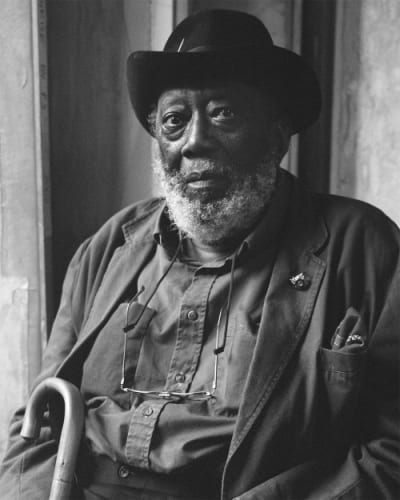Sir Frank Bowling OBE, RA (b. Guyana, 1934) moved to London in 1953, where his artistic career began shortly after winning a scholarship to study at London’s Royal College of Art (1959- 1962). Bowling studied alongside the stars of British Pop Art, including David Hockney and R. B. Kitaj. At his graduation, in recognition of his talent, Bowling won the silver medal for painting, second to Hockney’s gold. As the sixties dawned, Bowling’s unique and original style of combining figurative, abstract and symbolic elements meant he soon became a recognised figure in the London art scene.
After graduating, Bowling’s first solo exhibition ‘Image in Revolt’ was hosted at the respected Grabowski Gallery in London. In the years that followed he spent a significant amount of time between London and New York until he decided to move there in the late 60s. This decision was aided by his first Guggenheim Fellowship awarded in 1967 and allowed him to immerse himself in a new, more diverse cultural landscape. Bowling’s painting began to turn to abstraction – the field in which his contributions were to be most significant. His artworks became more geometrically complex, guided by principals of mathematics and symmetry. It is during this transitional period in the mid to late 60s that Bowling’s seminal body of work, the Map Paintings – a series of quasi-abstract colour fields overlaid with stencilled images of maps of Australia, South America and Africa – were produced. Around the same time, he also started contributing to Arts Magazine, writing seminal articles about Black Art at the height of the Civil Rights Movement, and as a result he played a key role in debates surrounding Black Art.
In 1971, Bowling met American art critic Clement Greenberg, who became an important influence and saw his work enter a new phase. Greenberg’s advice and encouragement helped remove any lingering doubts the artist had about his commitment to modernism, and the social/political imagery and narrative present in Bowling’s earlier work was replaced with an increasing focus on material, process, and colour. By this time, Bowling had developed a palette for large, light-filled, lyrical colour abstractions that distinguished his work from that of earlier Colour Field painters working in the USA such as Kenneth Noland, Jules Olitski or Larry Poons. However, never content to stop exploring and experimenting with the possibilities of paint, Bowling continued to innovate with new processes. He soon developed a bespoke tilting platform and a mechanical apparatus which tightened the canvas so he could pour paint onto it, creating the spontaneous fusions of layer and colour now known as the iconic ‘Poured Paintings’.
In the early 1980s, the influence of geometry became visible not just in Bowling's paintings, but also in the way he worked with canvas. He started using Styrofoam to create quasi-sculptural relief; his sculptural paintings often include objects and textures, embedded in the work as much as the legacies of both traditional English landscape painting and American abstraction. Bowling’s more recent works continue to explore the nature and possibilities of abstract painting, the diverse range of principles and processes explored across his career now converging and coalescing in dynamic new configurations of colour and form. His painterly experimentation has received critical acclaim, as the artist continues to orchestrate the emotive potential of colours to communicate a visual experience of uniquely sensuous immediacy.
Bowling’s career and contributions to the art world have been recognised worldwide. In 2005, Bowling became the first black British artist to be made a Royal Academician, in 2008 he was awarded an OBE for Services to Art, and in 2020 was awarded a Knighthood. The artist has exhibited nationally and internationally; selected solo shows include Whitney Museum of American Art, New York (1971); Serpentine Gallery, London (1986); a UK touring retrospective (2003); Royal Academy of Arts, London (2011); Spiritmuseum, Stockholm (2014-15); Dallas Museum of Art (2015); Haus der Kunst, Munich (2017), and in recent years Bowling was the subject of a BBC documentary, ‘Frank Bowling’s Abstract World’, which coincided with a retrospective exhibition at Tate Britain in 2019. Bowling's work can be found in numerous public and private collections including the Metropolitan Museum of Art (New York), Museum of Modern Art (New York), Museum of Fine Arts (Boston), Dallas Museum of Art (Dallas), Royal Academy of Arts (London), Tate Gallery (London), Victoria & Albert Museum (London), and the Whitney Museum of American Art (New York).
Bowling continues to work in his London studio almost every day with his partner, Lady Rachel Scott.
